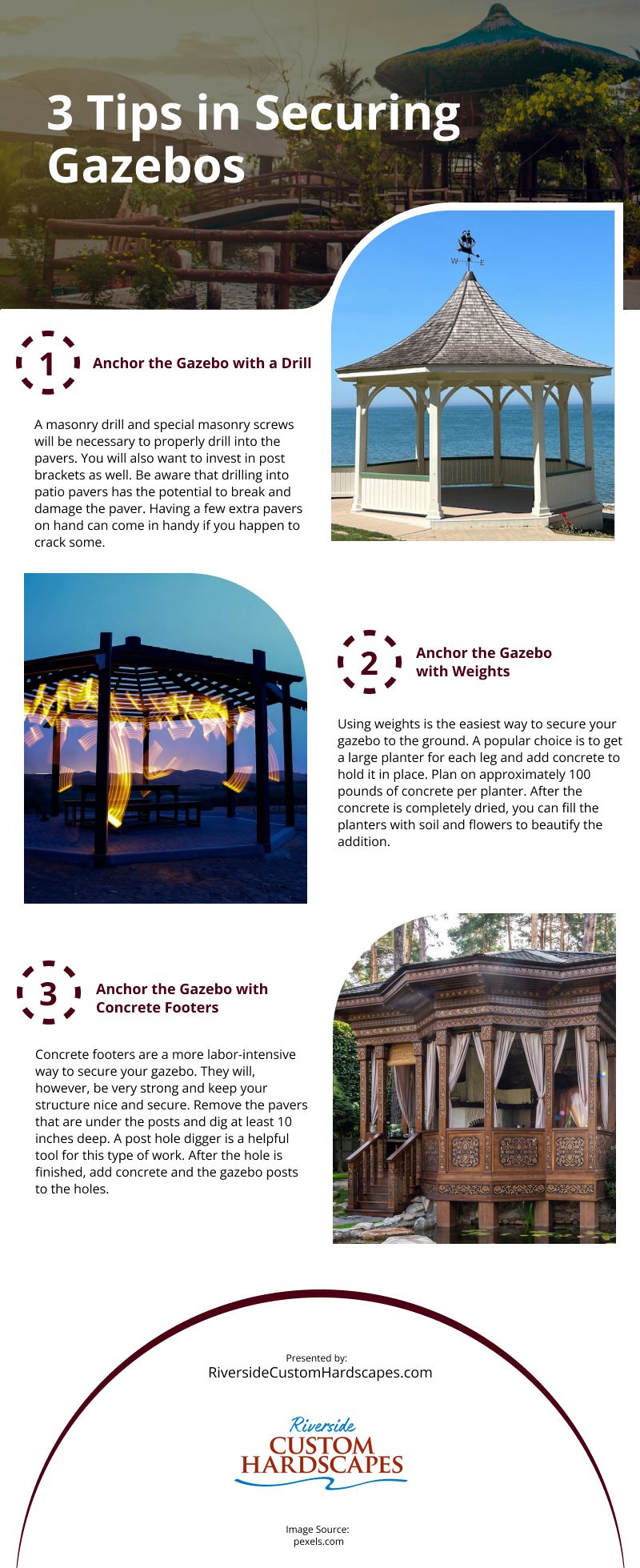
After the gazebo has been attached to the paver patio using the appropriate fasteners, it is time to secure the building itself. Anchors and/or tie downs are two options you have for ensuring that your gazebo is affixed to the ground in a safe and secure manner. Anchors are objects made of metal or plastic that can be attached to the bottom of the gazebo and then driven into the ground to provide additional support for the structure. Straps or ropes can be used to create tie-downs, which are used to secure gazebos to stakes that have been driven into the ground. This contributes to the structure’s increased resistance to being blown around by severe winds. During times of bad weather, your gazebo could pose a hazard if it is not securely fastened or secured to the ground. If you want your gazebo to be as risk-free as possible, you need to be sure that any anchors and tie-downs you use comply with the local building codes. In addition, you should inspect all anchors and tie-downs once a year to make sure they are in good working order. Last but not least, make it a habit to check the gazebo’s structure once every three to four months for signs of deterioration or damage that may have developed over the course of its use.
It is essential to be aware that certain types of gazebos are intended solely for usage as freestanding structures and must not have any kind of securing mechanism attached to them. Before attempting to attach the gazebo to the paver patio, it is imperative that you first check the gazebo’s instructions. You will be able to make the most of your gazebo on a paver patio for a good number of years to come so long as you provide it with some basic care and keep it maintained.
Masonry screws are what you’ll need to utilize to keep the gazebo in place. Masonry screws are manufactured to withstand the rigors of concrete and other types of tough materials, ensuring that they will not loosen over time or work themselves loose. To begin, drill pilot holes into the pavers in a manner that corresponds to the size and shape of the gazebo frame that you will be constructing. Carefully select the drill bit you will use, as it should be just a hair smaller in diameter than the masonry screws you will be using.
After the pilot holes have been drilled, you may next begin driving the masonry screws into their respective holes. Be sure to drive them in all the way so that they are level with the surface of the pavers. This will help to maximize the strength of the anchoring system for your gazebo by ensuring that there is a tight seal between the screws and the pavers.
After all of the masonry screws have been installed, you will be able to further secure the gazebo by adding some additional security features such as a ground anchor or tie down straps after all of the masonry screws have been installed. Tie down straps can be wrapped around your building and attached to stakes that have been driven into the ground, while ground anchors can be sunk beneath the surface and linked to your gazebo frame to provide further stability. Your gazebo will remain securely anchored to the ground thanks to the additional support that this provides, regardless of the weather conditions that may be present.
Following the completion of these processes, your gazebo should now be firmly attached to your paver patio and be ready for use. You may relax and take in the splendor of your outdoor space with complete satisfaction now that you know your gazebo is protected from potential threats.
Be sure to perform routine checks on your gazebo to ensure that it is still firmly attached to its location and that all of its connections are in good working order. Make sure that you check the masonry screws on a regular basis to verify that they have not gotten loose during the course of the project. Your gazebo will be safe and ready to use for a lot of years to come if you just give it a little bit of care every now and again.
source: https://www.riversidecustomhardscapes.com/how-to-secure-a-gazebo-on-a-paver-patio/
Comments
Download this infographic.
